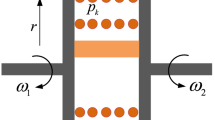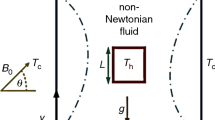Abstract
This research analyses the dynamic behavior of magnetic fluid that sloshes due to the pitching motion of the container. To analyze the behavior of magnetic fluid, we first analyze the equations that govern magnetic fluid as well as the momentum equation of the sloshing that results from a magnetic field. In each case, we conducted simulation and compared the results from simulation with those from experiments. When sloshing does not occur, the surface of the magnetic fluid rises towards the location of intensity of the magnetic field; in the absence of an additional, external body force, the fluid remains elevated. In case sloshing occurs simultaneously with the application of the magnetic field, the elevation of the surface as a result of the magnetic field is maintained. Further, we can confirm that if the excitation frequency of sloshing is small, the wave motion of the surface is small because the magnetic body force dominates the effect of sloshing. Even if the excitation frequency increases, the wave motion of the fluid surface is smaller than when a magnetic field is not applied. The fluid surface rises in that location where the intensity of the magnetic field is strong. Where the intensity of the magnetic field is weak, the height of the fluid surface is lower than the initial level that obtains in the absence of a magnetic field. Through the study, we can conclude that the sloshing behavior of magnetic fluid is influenced by the magnetic field intensity and distribution.
Similar content being viewed by others
References
D. Liu and P. Lin, A numerical study of three-dimensional liquid sloshing in tanks, J Comput. Phys., 227(8) (2008) 3921–3939.
T. Ikeda and R. A. Ibrahim, Nonlinear random responses of a structure parametrically coupled with liquid sloshing in a cylindrical tank, J Sound. Vib. Inter. 284(1–2) (2005) 75–102.
M. Abbas and Z. Mansour, Sloshing damping in cylindrical liquid storage tanks with baffles, J Sound. Vib. Inter. 311(1–2) (2008) 372–385.
H. S. Kim and Y. S. Lee, Optimization design technique for reduction of sloshing by evolutionary methods, Journal of Mechanical Science and Technology. 22 (2008) 25–33.
J. R. Cho and H. W. Lee, Free Surface Tracking for the Accurate Time Response Analysis of Nonlinear Liquid Sloshing, Journal of Mechanical Science and Technology. 19(7) (2005) 1517–1525.
S. Kamiyama, K. Ueno and Y. Yokota, Numerical analysis of unsteady gas-liquid two-phase flow of magnetic fluids, J Magn. Magn. Mater. 201(1–3) (1999) 271–275.
V. G. Bashtovoy, O. A. Lavrova, V. K. Polevikov and L. Tobiska, Computer modeling of the instability of a horizontal magnetic-fluids layer in a uniform magnetic field, J Magn. Magn. Mater. 252 (2002) 299–301.
R. Badescu, D. Condurach and M. Ivanoiu, Ferrofluid with Modified Stabilisant, J Magn. Magn. Mater. 202(1) (1999) 197–202.
M. I. Shliomis and B. L. Smorodin, Convective Instability of Magnetized Ferrofluids, J Magn. Magn. Mater. (252) (2002) 197–202.
K. Butter, A. P. Philipse and G. J. Vroege, Synthesis and properties of iron ferrofluids, J Magn. Magn. Mater. 252 (2002) 1–3.
M. Rasa and A. P. Philipse, Scanning probe microscopy on magnetic colloidal particles, J Magn. Magn. Mater. 252 (2002) 101–103.
R. Rosensweig, Ferrohydrodynamics, Cambridge: Cambridge University Press, 1985.
R. Yamane, S. Tomita, J. Mai, M. K. Park and S. Oshima, Oscillation of a diamagnetic liquid bubble suspended by magnetic force, J Magn. Magn. Mater. 252 (2002) 268–270.
R. Yamane, S. Ryuichiro, S. Oshima and M. K. Park, Magnetically suspended virtual divergent channel, J Magn. Magn. Mater. 289 (2005) 389–391.
S. Kamiyama, K. Koike and Z. S. Wang, Rheological properties of magnetic fluids with the formation of clusters: analysis of simple shear flow in a strong magnetic field, J Collo. and Inter. Sci. 127(1) (1989) 173–188.
C. Rindaldi, F. Gutman, X. He, A. D. Rosenthal and M. Zahn, Torque Measurement on Ferrofluid Cylinders in Rotating Magnetic Fields, J Magn. Magn. Mater. 289 (2005) 307–310.
A. Zeuner, R. Ritcher and I. Rehberg, Weak Periodic Excitation of a Magnetic Fluid Capillary Flow, J Magn. Magn. Mater. 201(1–3) (1999) 321–323.
M. Kroell, M. Prodoehl, G. Zimmermann, S. Pop and S. Odenbach, A. Hartwig, Magnetic and Rheological Characterization of Novel Ferrofluids, J Magn. Magn. Mater. 289 (2005) 21–24.
S. Sudo, I. Kazutaka and I. Toshiaki, Dynamics of Magnetic Fluid-Permanent Magnet System Subjected to Vertical Vibration, J Intel. Mater. Sys. Struc. 13 (2002) 539.
Author information
Authors and Affiliations
Corresponding author
Additional information
This paper was recommended for publication in revised form by Associate Editor Gihun Son
Hyung-Sub Bae received the M.S. degrees in Mechanical Engineering from Pusan National University, Korea, in 2004. His research interests are in hydraulic and smart fluid control such as magnetic fluid and MR fluid.
Young-Won Yun was born in Busan, Korea, in 1973. He received his B.S. in Mechanical Engineering from Donga University, Busan, Korea, in 2000. He also received his M.S. in Mechanical Engineering from Pusan National University, Busan, Korea, in 2003. He is currently working toward his Ph. D at Pusan National University. His current research interests are Electro-hydraulic systems and a robust controller.
Myeong-Kwan Park received the M.S. and Ph.D. degrees from Tokyo Institute of Technology, Tokyo, Japan, in 1988 and 1991, respectively, in mechanical engineering. From 1991 to 1992, he served as a Research Associate in Department Mechanical Engineering, Tokyo Institute of Technology. He is currently a full professor with Department of Mechanical Engineering and a Researcher in the Research Institute of Mechanical Technology at Pusan National University. His research interests are in hydraulic and smart fluid such as magnetic fluid, ER fluid and MR fluid.
Rights and permissions
About this article
Cite this article
Bae, HS., Yun, YW. & Park, MK. Flow response of magnetic fluid surface by pitching motion. J Mech Sci Technol 24, 583–592 (2010). https://doi.org/10.1007/s12206-010-0109-x
Received:
Revised:
Accepted:
Published:
Issue Date:
DOI: https://doi.org/10.1007/s12206-010-0109-x




